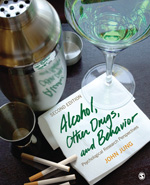Providing a psychological perspective on the use and abuse of alcohol and other psychoactive drugs, this Second Edition includes more coverage of the theories of alcohol and other drug use and abuse, as well as broad conceptual issues related to the nature of addiction and recent developments in research methods.
Key Features
- Focuses on alcohol, which is used more widely than any other drug, and the one that is associated with the most societal harm
Evaluates important studies on major issues, concepts, and theories rather than providing exhaustive literature reviews
Teaches students to become educated consumers of research findings, rather than passive or uncritical recipients
Ancillaries
A
Student Study Site at
www.sagepub.com/jungstudy with chapter summaries, multiple-choice quizzes, flashcards for glossary items, an annotated list of relevant Web sites, informational QuickTime movies, and SAGE journal articles.
Intended Audience
This text is appropriate for upper-level undergraduate courses in Drugs and Behavior, Psychology of Addiction, and Drug Abuse Counseling. It can also be used in graduate-levelcourses in Drugs and Behavior and Addiction courses taught in health science, social work, criminal justice, and nursing.
ISBN: 9781483389455
eBook
Suggested Retail Price: $130.49
Bookstore Price: $104.39
ISBN: 9781483389455
eBook
Suggested Retail Price: $72.00
Bookstore Price: $57.60
ISBN: 9781483389455
eBook
Suggested Retail Price: $81.00
Bookstore Price: $64.80
ISBN: 9781483389455
eBook
Suggested Retail Price: $90.00
Bookstore Price: $72.00
ISBN: 9781412967648
Paperback
Suggested Retail Price: $195.00
Bookstore Price: $156.00
See what’s new to this edition by selecting the Features tab on this page. Should you need additional information or have questions regarding the HEOA information provided for this title, including what is new to this edition, please email sageheoa@sagepub.com. Please include your name, contact information, and the name of the title for which you would like more information. For information on the HEOA, please go to http://ed.gov/policy/highered/leg/hea08/index.html.
For assistance with your order: Please email us at textsales@sagepub.com or connect with your SAGE representative.
SAGE
2455 Teller Road
Thousand Oaks, CA 91320
www.sagepub.com
Focus and Goals of This Book
History of Drugs in America
Origins of Licit Drugs
Origins of Illicit Drugs
Some Central Questions
Summary
Stimulus/Response
A "Layperson" Theory
Psychological Theories
Mediators, Moderators, and Direct Causes
Theories of Smoking
Theory of Caffeine Use
Illicit Drug Theory
Summary
Stimulus/Response
Defining Use
Methods Of Measuring Use
Use, Abuse, and Dependence
Major Conceptions of Alcohol Use Disorders
Criteria of Abuse and Dependence
Assessment of DSM-IV Disorders
Summary
Stimulus/Response
The Epidemiological Approach
National Surveys of Alcohol and Other Drug Use
Stability of Alcohol Use Patterns
Abuse and Dependency Rates
Comorbidity of Alcohol and Illicit Drugs
Other Sources of Data
The Ethnographic Approach
Summary
Stimulus/Response
What Happens After Drugs Are Taken?
How Drugs Affect the Nervous System
How Neurons Communicate
How Alcohol and Other Drugs Affect Neurotransmission
Changes in Neurophysiology With Prolonged Drug Use
Neuroadaptational Models
Physical Effects of Drugs
A Safe Level of Alcohol Use?
Summary
Stimulus/Response
Molecular Genetics
Indirect Evidence of Hereditary Influences on Alcoholism
Direct Evidence of Hereditary Influences on Alcoholism
Family Environment Influences
Integrative Models of Heredity and Environment
Summary
Stimulus/Response
Methodological Issues
Mood and Emotion
Emotional Regulation and Drinking
Sensory Motor Activity
Cognition
Structural Neuropsychological Explanations
Process Neuropsychological Explanations
Summary
Stimulus/Response
Aggression
Moderators of the Alcohol-Aggression Relationship
A Moderator Variable Model
Sexual Activity
Summary
Stimulus/Response
Alcohol and Marital Status
Effects of Parental Alcohol Use Disorders on Children
Alcoholic Family Interactions
Adult Children of Alcoholics
Codependency
Summary
Stimulus/Response
Adolescents
College Students
Young Adults
Older Populations
Age, Cohort, and Period Effects
Summary
Stimulus/Response
Methodological and Conceptual Issues
Gender and Prevalence of Alcohol Use
Gender Correlates of Alcohol and Other Drug Use
Gender and Alcoholism Treatment
Theories of Gender Differences in Alcohol and Other Drug Use
Smoking and Gender
Gender and Other Drug Use
Summary
Stimulus/Response
Racial/Ethnic Minority Groups and Alcohol
Racial/Ethnic Minority Groups and Smoking
Racial/Ethnic Minority Groups and Illicit Drugs
Influence of Acculturation on Alcohol and Other Drug Use
Sexual Minority Groups and Alcohol
Summary
Stimulus/Response
Motivating Change
Methods of Recovery
Alcoholics Anonymous and Related Mutual Help Groups
Behavioral Model
Self-Help Treatment for the Family of Alcoholics
Natural Recovery
Stimulus/Response
Typical 28-Day Inpatient Treatment
Size of the Treatment Population
Reasons for Not Seeking Treatment
Psychotherapy
Behavioral Approaches
Family Therapy
Brief Intervention Therapy
Early Detection and Screening
Pharmacological Approaches
Combining Behavioral and Pharmacological Treatment
Evaluation of Treatment Programs
Determining How Effective Therapies Work
Matching Patients and Treatments
Alcoholics With Dual Diagnoses
Other Drugs: Treatment of Abuse and Dependency
Smoking Treatments
Summary
Stimulus/Response
Defining Relapse
Craving and Relapse
A Dynamic Model of Relapse
Successful Lapse Resistance
Summary
Stimulus/Response
Social Policy and Drugs
The Public Health Model
Primary Prevention
Secondary Prevention
Harm Reduction Approach
Promoting Social Change
A Tale of Two Drugs
The Future of Prevention
Summary
Stimulus/Response
Glossary
References
Index
About the Author
The student study site includes chapter summaries, quizzes, journal articles, web resources, chapter videos, and e-flashcards.
The instructor's resource site includes a PowerPoint slide and test questions.

